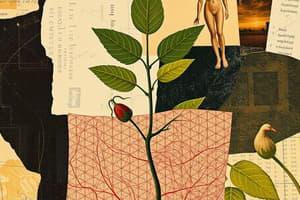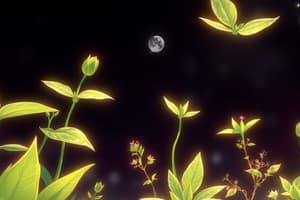Podcast
Questions and Answers
What process do plants primarily use to convert sunlight into energy?
What process do plants primarily use to convert sunlight into energy?
- Photosynthesis (correct)
- Transpiration
- Chemosynthesis
- Respiration
What is a key characteristic of plant cells?
What is a key characteristic of plant cells?
- Flexible cell membrane
- Lack of chloroplasts
- Both photosynthesis and respiration
- Rigid cell wall made of cellulose (correct)
Which type of plants reproduce via spores?
Which type of plants reproduce via spores?
- Gymnosperms
- Non-vascular plants
- Angiosperms
- Ferns (correct)
How do vascular plants transport water and nutrients?
How do vascular plants transport water and nutrients?
What role do plants play in climate regulation?
What role do plants play in climate regulation?
Flashcards
Photosynthesis in plants
Photosynthesis in plants
The process where plants use sunlight, carbon dioxide, and water to create glucose (food) and oxygen.
Plant cell wall
Plant cell wall
A rigid outer layer of plant cells made of cellulose, providing support.
Vascular plants
Vascular plants
Plants with specialized tubes (xylem & phloem) to transport water and nutrients throughout the plant.
Angiosperms
Angiosperms
Signup and view all the flashcards
Plant role in oxygen production
Plant role in oxygen production
Signup and view all the flashcards
Study Notes
Plant Characteristics
- Plants are multicellular organisms vital to life on Earth, belonging to the Plantae kingdom.
- They perform photosynthesis, converting sunlight into energy using chlorophyll.
- Plants use chloroplasts to convert sunlight, carbon dioxide, and water into glucose and oxygen.
- Plant cells have rigid cell walls made of cellulose, providing structural support.
- Plants grow throughout their lives, using meristems (regions of active cell division).
- Plants reproduce both sexually (via seeds or spores) and asexually (via cuttings, tubers, or runners).
Types of Plants
- Non-vascular Plants: Lack vascular tissue (xylem and phloem) and are small, like mosses and liverworts.
- Vascular Plants: Have xylem and phloem for water and nutrient transport.
- Ferns: Reproduce via spores.
- Gymnosperms: Produce seeds but no flowers (e.g., pine trees).
- Angiosperms: Flowering plants; the largest group of plants.
Importance of Plants
- Oxygen Production: Plants release oxygen as a byproduct of photosynthesis, vital for animal life. Essential for animal life
- Food Source: Plants form the base of the food chain.
- Habitat: Provide shelter and habitats for countless organisms.
- Medicine: Many plants are used in traditional and modern medicine.
- Climate Regulation: Plants absorb CO2 and help reduce greenhouse gases.
Studying That Suits You
Use AI to generate personalized quizzes and flashcards to suit your learning preferences.




